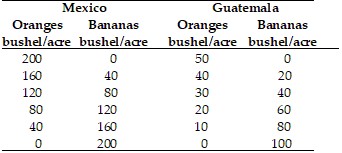Refer to the information provided in Table 20.1 below to answer the question(s) that follow. Table 20.1 Refer to Table 20.1. In Guatemala, the opportunity cost of 1 bushel of bananas is
Refer to Table 20.1. In Guatemala, the opportunity cost of 1 bushel of bananas is
A. 1/2 bushel of oranges.
B. 1 bushels of oranges.
C. 2 bushels of oranges.
D. 4 bushels of oranges.
Answer: A
You might also like to view...
Suppose you have one hour to catch a flight to Miami for spring break, and it takes 45 minutes to drive to the airport. Your car is almost out of gas and the price of gas at the closest gas station is higher than at other gas stations that are much farther away. To you, the price elasticity of demand for gas is likely to be ________ than it would be if you had several hours before the flight.
A. more variable B. higher C. lower D. no different
We assume that the representative consumer's preferences exhibit the properties that
A) they evolve over time and that more is always preferred to less. B) more is preferred to less and that the consumer prefers diversity. C) the consumer likes diversity and that more is sometimes preferred to less. D) more is sometimes preferred to less and that consumption and leisure are both normal goods.
At levels of output close to full employment, the aggregate supply curve is probably
a. very flat. b. very steep. c. sloped downward. d. perfectly elastic.
A monopolistically competitive industry combines elements of both competition and monopoly. The monopoly element results from:
A. the likelihood of collusion. B. high entry barriers. C. product differentiation. D. mutual interdependence in decision making.